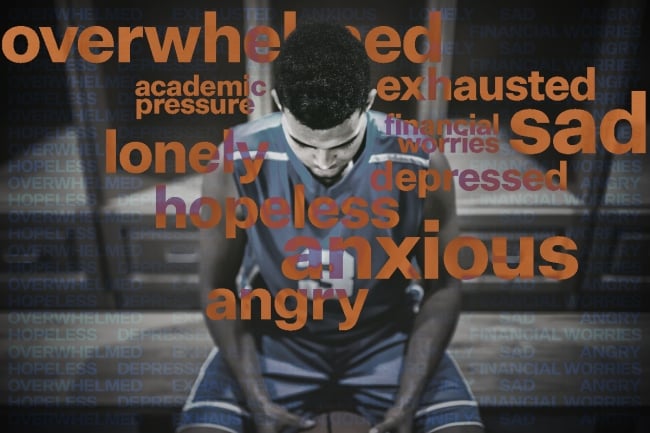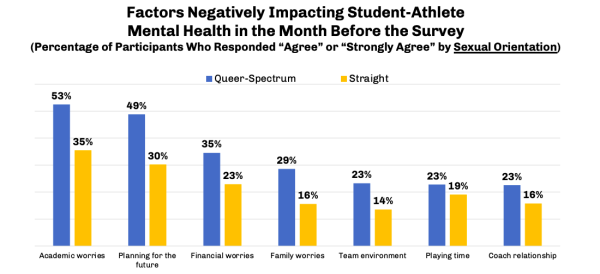You have /5 articles left.
Sign up for a free account or log in.

Top mental health symptoms for student athletes included feeling overwhelmed and mentally exhausted.
Photo illustration by Justin Morrison/Inside Higher Ed | Getty Images
The mental health of student athletes has improved since the pandemic, the NCAA’s latest Student-Athlete Health and Wellness Study shows, with fewer athletes reporting feeling overwhelmed, mentally exhausted or lonely than at the height of the COVID-19 outbreak.
But disparities remain; female athletes, athletes of color and LGBTQ+ athletes still report disproportionately high rates of struggling with their mental health.
The four most common mental health concerns for all athletes surveyed were insomnia, mental exhaustion, anxiety and feeling overwhelmed. Women experienced all four symptoms at much higher rates than men; 44 percent of female athletes reported feeling overwhelmed, for example, compared to just 17 percent of male athletes.
And while all four symptoms decreased among male athletes since fall 2021, for female athletes, rates of sleeplessness and anxiety remain about the same as they were two years ago.
Nonwhite athletes also reported a different set of factors impacting their mental well-being than their white peers. While student athletes of all races said academics had negatively affected their mental health recently, nonwhite students were much more likely to say they were stressed by financial concerns and worries about the future; 35 percent of Black student athletes cited financial worries, compared to 19 percent of white student athletes, for instance. Students of color were also more likely to cite concerns about their families, their playing time, their relationship with the coach and team environments. Similarly, LGBTQ+ students were more likely than their cisgender and straight peers to have been negatively impacted by those same stressors.

NCAA Student-Athlete Health and Wellness Study
Such trends are in line with the larger student population, as well as the general population outside higher education. Nevertheless, the mental health disparities between students of different races have led the NCAA, which surveyed more than 23,000 student athletes from its member institutions during the 2022–23 academic year, to re-evaluate its Mental Health Best Practices, a document that provides athletic and sports medicine departments of all sizes with recommendations for supporting players’ mental health. New guidance, which is slated for release in early 2024, will incorporate specific advice on supporting athletes of color and LGBTQ+ athletes.
“This update, following some of that data that we have found, [will] speak to risk and protective factors specifically for diverse student athlete populations,” said Carey Wheelhouse, director of health promotion for the NCAA Sport Science Institute.
Betsy Cutler, a consultant who specializes in student athlete mental health, said the survey results show a clear need for resources and support groups tailored to the needs of minority students.
“I’m not surprised at the percentage difference between our BIPOC and our LGBTQ+ community. I was actually a little caught off guard by the difference in the females,” she said. “It just highlights our need to have conversations and programming specific for … our LGBTQ and our BIPOC student athletes as well. There needs to be education that is tailored to our vulnerable populations.”
Seeking Help
Other key findings showed that athletes have a thorough understanding of how to get help; 67 percent of male and 72 percent of female athletes said they know where on campus they can go to address their mental health concerns—though only about half of all athletes said they would feel comfortable seeking support from the mental health providers on campus. More than a quarter of male athletes indicated they would feel “inadequate” if they sought help from a therapist, for example, compared to 14 percent of female athletes.

NCAA Student-Athlete Health and Wellness Study
Cutler noted that she would have been interested to know how those numbers translate to students actually seeking out help from their college’s counseling centers; some institutions have clinicians within their athletics departments, while others do not.
Insecurities about accessing therapy can exacerbate other barriers for student athletes—such as the limited hours some counseling centers are open and concerns about how well such centers can handle the specific needs of student athletes—deterring them from seeking help even when they know where to look, she said.
The report also showed that athletes feel less confident about sharing their mental health struggles with their coaches than they have in previous years. In 2019, a previous NCAA survey of student athletes found that 62 percent of male athletes and 49 percent of female athletes said they would feel comfortable talking with a coach about mental health issues; in the latest survey, those numbers dropped to 54 percent and 40 percent, respectively.
The forthcoming updates to the NCAA Mental Health Best Practices may help bolster athletes’ conversations with both members of the athletics department and their teammates. According to Wheelhouse, the guidelines will place increased emphasis on “health promotion,” which, she said, involves “trying to help create an environment where it’s just normalized to talk about mental health, to seek care for mental health, to know who and where to go to for mental health care.”








